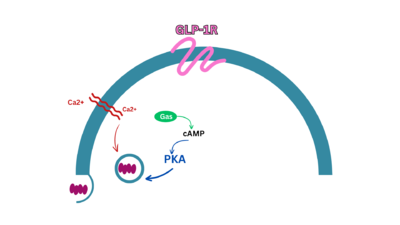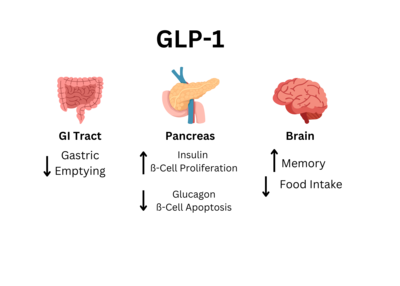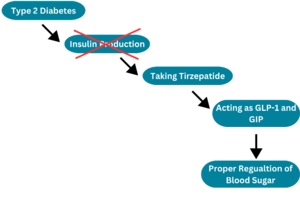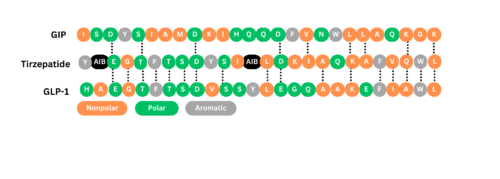User:Lily Lindemann/Sandbox1
From Proteopedia
(Difference between revisions)
| Line 6: | Line 6: | ||
[[Image:GLP Body Effect Graphic.png|400 px|right|]] | [[Image:GLP Body Effect Graphic.png|400 px|right|]] | ||
| - | <scene name='10/1038821/Hormone-receptor/6'>Glucagon-Like Peptide 1 Receptor or GLP1-R uses the glucagon-like peptide</scene>to signal the body to secrete insulin and inhibit glucagon secretion. When glucose levels in the blood rise (usually after consuming food), GLP-1R activates, creating a signaling cascade to signal cAMP. After the signaling cascade, the final result is the secretion of insulin to the rest of the body. Discovered in 1990s while trying to understand the mechanism of GLP-1 action. [https://www.biochempeg.com/article/299.html#:~:text=In%20the%201970s%2C%20the%20first,(Figure%201)%20were%20unraveled] The structure was determined using cryogenic electron microscopy. | + | <scene name='10/1038821/Hormone-receptor/6'>Glucagon-Like Peptide 1 Receptor or GLP1-R uses the glucagon-like peptide</scene> to signal the body to secrete insulin and inhibit glucagon secretion. When glucose levels in the blood rise (usually after consuming food), GLP-1R activates, creating a signaling cascade to signal cAMP. After the signaling cascade, the final result is the secretion of insulin to the rest of the body. Discovered in 1990s while trying to understand the mechanism of GLP-1 action. [https://www.biochempeg.com/article/299.html#:~:text=In%20the%201970s%2C%20the%20first,(Figure%201)%20were%20unraveled] The structure was determined using cryogenic electron microscopy. |
| Line 19: | Line 19: | ||
[[Image:pathway.png|300 px|left|thumb|Nonfucnctional Pathway due to Type II Diabetes]] | [[Image:pathway.png|300 px|left|thumb|Nonfucnctional Pathway due to Type II Diabetes]] | ||
Type II Diabetes is when the pancreas does not produce enough insulin for the body.[https://www.mayoclinic.org/diseases-conditions/diabetes/symptoms-causes/syc-20371444] This in turn makes the blood glucose level dangerously low. When the sugar levels in our blood become too low people can become dizzy and tired. On the other hand, when blood sugar levels become too high then can become feverish and sick. The decrease in blood sugar can be related to a decrease in GLP-1 within the body. | Type II Diabetes is when the pancreas does not produce enough insulin for the body.[https://www.mayoclinic.org/diseases-conditions/diabetes/symptoms-causes/syc-20371444] This in turn makes the blood glucose level dangerously low. When the sugar levels in our blood become too low people can become dizzy and tired. On the other hand, when blood sugar levels become too high then can become feverish and sick. The decrease in blood sugar can be related to a decrease in GLP-1 within the body. | ||
| - | |||
Revision as of 12:59, 25 April 2024
Glucagon-Like Peptide 1 Receptor (GLP1-R)
| |||||||||||




